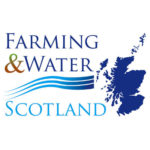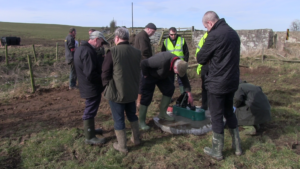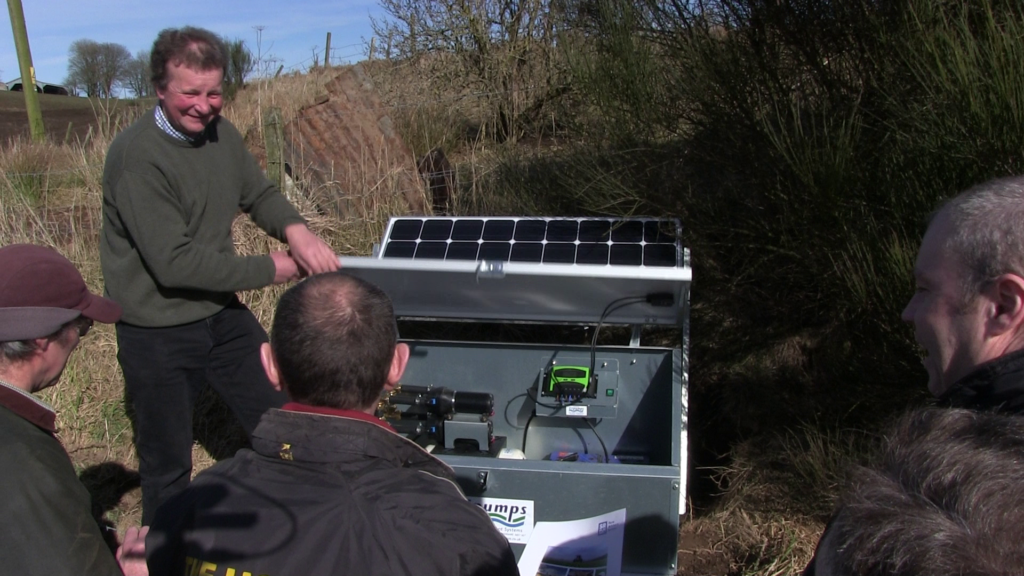Pumps and Troughs: What are the alternatives to waterings? – Event Summary
22 March 2018This event was held near Fyvie & focussed on what the alternatives were to traditional waterings- which can lead to diffuse pollution from contamination to soil erosion from poaching.
The Firm of Harry Milne (with support from the Scottish Government) has installed three troughs filled by a solar pump, and a pasture pump, replacing 4 waterings.
After George Chalmers introduced the meeting attendees were shown the new installations in-situ. Gavin Elrick was on hand to answer questions about the engineering aspects and Kevin Rudland answering those of a legislative nature.
The group then moved to the Royal British Legion where George showed the group a presentation showing a “before, during and after” look at the site. Gavin then gave a presentation on the different types of pumps available for farmers and explained a little about why each option might be better suited to different situations and uses.
SEPA’s Pete Wright then discussed the new Ythan Priority Catchment, before Kevin then expained how farmers can get lots of useful information from the Farming & Water Scotland webpage. Read Pete’s presenation slides here.
To conclude, George gave a brief overview of funding available for similar projects through the SRDP Agri-Environmental Climate Scheme, band highlighted to everyone that the application window for this year will close on 13th April.
Key Messages
- Waterings can lead to diffuse pollution from livestock and soil erosion. It is important for producers to look at alternatives.
- Every site has a different solution with numerous considerations- proximity to mains water, type of stock, number of stock etc.
- There are a wide variety of pumps available ranging from those seen on site (solar and nose pumps) to many other different types.
- Most local rivers in the North East are now deemed as Priority Catchments raising the profile of potential diffuse pollution issues.
- It is important to know the legislation regarding siting troughs etc- e.g. can be no less than 5 m from the top of the bank of a watercourse.
- Funding for alternative watering projects can be available through AECS
 Please use the links below to download information that was available to take away on the day.
Please use the links below to download information that was available to take away on the day.
You can find more information about reducing the risk of rural diffuse pollution and Scotland’s Diffuse Pollution Priority Catchments on the Farming & Water Scotland webpage.
- Technical Note (TN665) – Alternative watering for field grazed livestock I – Abstraction systems
- Topics: Water Management
- Technical Note (TN665): Alternative Watering for Field Grazed Livestock I – Abstraction Systems
- This technical note presents two different abstraction point designs to supply an alternative watering system, based on findings from Scottish Government funded trial work on three farms in Scotland.
- Topics: Water Management and Livestock
- Pumps & Troughs – What are the alternatives to waterings? Presentation (1) slides
- These are the slides from the first presentation during the Fyvie event - Pumps & Troughs - what are the alternatives to waterings.
- Topics: Water Management
- Pumps & Troughs event Fyvie – Presentation (2) slides: Alternatives to Waterings
- These are the slides from the second presentation at the Pumps & Troughs- what are the alternatives to watering event, Fyvie
- Topics: Water Management
- Pumps & Troughs – What are the alternatives to waterings? Presentation (3) slides
- These are the slides used by Pete Wright, SEPA, during the third presentation at the Fyvie Pumps & Troughs, What are the alternatives to waterings? event
- Topics: Water Management
Sign up to the FAS newsletter
Receive updates on news, events and publications from Scotland’s Farm Advisory Service


